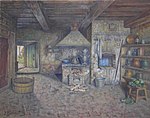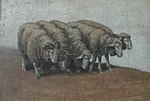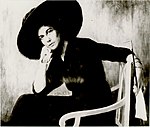Siegfried Bielenstein
Siegfried Alexander Bielstein (* February 15 . Jul / 27. February 1869 greg. Lett in Doblen (. Dobele ), Courland Governorate , now part of the country Zemgale ; † 25. February 1949 in Senftenberg in Brandenburg) was a Baltic German painter and graphic artist. In Latvian texts he is quoted as Zigfrīds Aleksanders Bīlenšteins , in Russian Зигфрид Александр Биленштейн and in personal circles called Six . He is considered one of the main representatives of Baltic German impressionism .
family
Siegfried Bielenstein was the son of the pastor, linguist and ethnographer August Bielenstein and his wife Erna, b. from Bordelius. His siblings were Max Bielenstein (1855–1860), the pastor Louis Johann Emil Bielenstein (1858–1943), the author Martha Bielenstein (1860–1938), the pastor and martyr Hans Bielenstein (1863–1919), Johanna Bielenstein (1864–1938) 1864), Emma Bielenstein (1865–1887), the pastor Walter Adolf Axel Bielenstein (1872–1961) and the architect Bernhard Max August Bielenstein (1877–1959).
Life
After teaching at home, Siegfried Bielenstein attended the secondary school in Mitau (Lat. Jelgava ) from 1894 until he graduated from high school. He then attended the cadet institute in St. Petersburg . There he was a volunteer in the rifle battalion of the royal family in Krasnoye Selo . From 1891 he studied at the University of Leipzig and at the Weimar Art Academy with the animal painter Albert Heinrich Brendel , the landscape and animal painter Giulio Aristide Sartorio and the portrait specialist Max Thedy . In 1897 he left Weimar after graduating with the medal for art and science. Even later he occasionally returned to Weimar. From 1897 to 1939 Bielenstein lived as a painter and drawing teacher in Riga. In 1906 he married Steffanie Auguste Valerie von Erdberg-Krczenciewski (* 1880), who also took a lively part in the cultural life in Riga. Steffanie, also known as Stephanie or Steffi , appears on paintings by various artists. The marriage remained childless and ended with Steffanie's death in 1946. Through the resettlement following the Hitler-Stalin Pact , he came to Posen (Polish: Poznań). In 1945, after fleeing from the Warthegau, he came to Senftenberg, where he died in 1949.
plant
Even his father urged him to restore the works of art in churches. Siegfried Bielenstein was entrusted with the decoration and organization of events. His paintings were presented on the stage in the form of living images . He participated in exhibitions in Mitau, Riga and Poznan. He had solo exhibitions in Riga and Mitau.
As a result of resettlement and flight, many works have gone missing. Portraits, landscapes, urban scenes, animal pictures and interiors in oil painting have been preserved . In addition, charcoal drawings and bookplates . The Archduke of Weimar, Karl Alexander, Nietzsche, Wildenbruch, Sarasate and Richard Strauss sat for him as models for paper cutouts . The art scene in Riga and Libau (Lat. Liepāja ) celebrated his 70th birthday . He donated his own works for raffles for charitable purposes.
He has designed quartet plays several times . The maps, published in 1925, show historical buildings from the Baltic States. For the family he painted a sentence of Black Peter that did not go to press. In 2005 the German-Baltic-Latvian center DOMUS RIGENSIS organized a memorial exhibition for Siegfried Bielenstein in Riga.
Works (selection)
- gallery
literature
- Ināra Korsaka: Siegfried Alexander Bielenstein. His life (German and Latvian) in: Accompanying volume of the memorial exhibition Siegfried Alexander Bielenstein. Life and Work, Domus Rigensis, Riga 2005.
- Ojārs Spārītis : The Art of Siegfried Alexander Bielenstein (German and Latvian) in: Accompanying volume of the memorial exhibition Siegfried Alexander Bielenstein. Life and Work, Domus Rigensis, Riga 2005.
- Kuno Hagen: Lexicon of Baltic German visual artists . Verlag Wissenschaft und Politik, Cologne 1983.
- Wilhelm Neumann: Lexicon of Baltic artists . Jonck & Poliewsky Verlag, Riga 1908. Reprinted by Harro von Hirschheydt Verlag, Hanover 1972.
- Our home town. Baltic songs . With picture: "My home". By Siegfried Bielenstein. Verlag Jonck & Poliewsky, Riga, 2nd edition 1907. From the foreword: The suggestion for the present collection came from German women - the constructive work of German women is to benefit from the proceeds of the little book.
- Oskar Grosberg : Latvia, country and people. Chat book . With pen drawings by Siegfried Bielenstein. Ruetz Verlag, Riga 1930. (Several reprints have been published)
- Riga Architects' Association: Yearbook for Fine Arts in the Baltic Sea Provinces 1907 (1st year) With 5 paintings and drawings by Siegfried Bielenstein.
- Yearbook of Baltic Germanship 1930. , Page 102: Portrait of the artist's wife.
- Baltic ladies calendar for 1910 (25th year). With pictures of the month and black and white vignettes by Siegfried Bielenstein. Verlag der Buch- und Kunsthandlung E. Bruhns, Riga 1909.
- Baltic calendar 1910 (1st year). Artist calendar by Siegfried Bielenstein. (The monthly pictures show women's costumes from the Baltic States). Verlag der Buch- und Kunsthandlung E. Bruhns, Riga 1909.
- Baltic quartet game . With historical notes by Karl von Löwis of Menar and drawings by Siegfried Bielenstein. Jonck & Poliewsky Publishing House, Riga 1925.
Web links
- Baltic Historical Commission (Ed.): Entry to Bielenstein, Siegfried. In: BBLD - Baltic Biographical Lexicon digital
- Galerija Antonija, interior with lamp . Oil on canvas 56 × 71 cm
- Galerie Mākslas Vēstniecības, Riga: Roofs of the Old Town of Riga , 1917. Oil on canvas, relined on cardboard, 45 × 37 cm.
- Galeria Antonija, Riga: Interior workshop of W. Radetzky , 1914. Oil on cardboard 50 × 40.5 cm.
- Galeria Antonija, Riga: Shepherd . Oil on canvas 44 × 113 cm.
- Mākslas Vēstniecība Gallery, Riga: White Horse , 1935. Oil on cardboard 30 × 35 cm.
Individual evidence
- ↑ August Johann Gottfried Bielenstein and family in the German biography.
- ↑ Saulcerīte Viese: Pārdomas par Bīlenšteinu dzimtu (information about the Bielenstein family) with a portrait of his father.
- ↑ Family tree of the von Bordelius family
- ↑ On the history of the Doblen church , in: Baltic monthly magazine of January 1, 1896, p. 24: "Restoration of epitaphs and other ornaments in the church in Doblen by Siegfried Bielenstein."
- ^ Decoration for the Böcklin celebration by Siegfried Bielenstein . In: Rigasche Stadtblätter , May 11, 1901.
- ↑ Rigasche Zeitung of May 2, 1907 : Ceremony in the large guild with a "living picture" based on a painting by Siegfried Bielenstein: "My home" and song based on Mickwitz's home song.
- ^ Riga on Sunday, February 15, 1931 : Exhibition in the City Art Museum. […] We immediately notice this striving for salary with Siegfried Bielenstein. In his “Blue Room” there is an atmosphere of cosiness and intimacy, and the furniture, caressed by rays of sunshine, seems to talk about bygone times. The picture has a nice depth effect and the colors are bright and strong. The "Bauernstube" should also be mentioned. Bielenstein doesn't just show us interiors. We also know him as a good portrait painter. The "Portrait of Mr. F." is tackled lively, it speaks of a noble attitude. [Harry Kaplan]
- ^ Rigasche Rundschau of April 16, 1932 : Exhibition of German artists in Latvia. [...] Siegfried Bielenstein has supplied the exhibition with some well-made oil paintings. In the “morning toilet” the beautiful contrast between the deep blue and the red of the stone jugs is a delight. “My Atelier” exudes comfortably, where one notices, in miniature, the sunlit landscape that hangs a few meters further in the frame. [Arthur Knüpffer].
- ↑ Rigasche Post of May 12, 1935 : Painting exhibition by German artists in Latvia. […] S. Bielenstein shows several large portraits. But it is mainly attractive in its lovingly given interiors, which have a subtle hint of Spitzweg. ( Susa Walter )
-
^ Rigasche Rundschau of March 6, 1925: Exhibition of German artists in Latvia. By Guido Hermann Eckardt . […] In the first of the two well-known rooms of the Municipal Museum there are portraits of Siegfried Bielenstein ; and underneath it most lively, happy in the spatial arrangement of the personal and the apprehension of the individual. Such is the portrait of an officer, which is superbly presented against a monotonous bluish background. The head is just as simple in its fine expression as it is in an attitude of strong characteristics. This portrait has a natural definiteness: this is what someone looks like, there is no doubt about it. And yet nothing of the peculiarity of the model is accentuated with any preferential clarity or even vehemence, the representation remains a sure calm with every move. This content-rich, effortlessly concentrated approach is also encountered in the very different, amiably informal portrait composition "Mother and Child" by the same painter. You stay in a balcony-like room against a well-closing architecture behind it and are perfectly connected to each other in a childlike serenity and completely surrounded by streaming light and bright air. It has succeeded in expressing something strongly relational, without a cute genre-like sounding in this amusement.
Bielenstein's portrait of Kommerzienrat V. The portrait of a gentleman with a vase as a sought-after point in space is also expressive in the head, but the black skirt with its equally smooth surface devours the figure and appears awkward. Just as the artist's self-portrait does not appear essential in the living studio. Of the other Bielensteins, the actor Max Krall [,] as a monk should be mentioned, while the other portrait of Krall remains stuck in a generally mask-like manner. [...] - ^ M. Piotr Michałowski: The collection of Baltic art in the National Museum in Poznan. In: Yearbook of the Federal Institute for East German Culture and History , Vol. 2 (1994), ISBN 3-486-56048-4 . There it says in the chapter Painting of the 20th Century (until 1945) (p. 239): “These holdings represent a quite random collection of pictures by Baltic German artists who worked in Poznan from 1939 to 1945 and also had exhibitions there. Siegfried Bielenstein [...] The Poznan portrait study 'Bauer' was certainly made in the last years of his life in Poznan (approx. 1943) [...]. "
- ^ Düna-Zeitung, November 10, 1900 : In the art salon (Bastei-Boulevard 9a) exhibition of an art collection from the private collection of the painter Siegfried Bielenstein.
- ↑ Düna newspaper of December 23, 1903 : Art Salon. Exhibition Siegfried Bielenstein . It is a considerable sum of good work and persistent diligence that speaks to the viewer from the paintings, studies, sketches and drawings of Mr. S. Bielenstein. Above all, the artist is an exact draftsman, and you can feel that from the oil paintings, especially from the landscapes, where the contours are particularly emphatic, and the funny, the easy transition from the representational to the environment flowing in light and air is missing. It is also the diligence of the keen draftsman that puts his stamp on the study heads and pictures of people and I would like to claim that it is precisely these paintings, meticulously worked out in the old, smooth manner in rich, warm colors, which look like copies of the works of old masters (No. 6, 8, 20, 58 and others) are the best that Mr. Bielenstein offers us. […] (A detailed description of the Bielenstein exhibition in the art salon follows).
- ^ Düna newspaper of October 20, 1903 : Siegfried Bielenstein's exhibition with 95 pictures and sketches in Mitau.
- ↑ Rigasche Rundschau of February 25, 1939 : Oskar Grosberg on the 70th birthday of Siegfried Bielenstein (with portrait photo).
- ↑ Rigasche Post of February 26, 1939 : M. Held: Like a tree in mother earth , on the 70th birthday of Siegfried Bielenstein (with portrait photo)
- ↑ Rigasche Rundschau of April 28, 1939 : Siegfried Bielenstein donates four paintings to the lottery of the Landeswehrverein: interiors and depictions of soldiers.
- ↑ Riga, the European Capital of Culture 2014 in the “Baltic Quartet Game” from 1925 Acquisition of a quartet game by the Herder Society
- ^ Baltic quartet games at the European Game Collectors Guild.
- ↑ B. Sila: Bīlenšteins atkal Rīgā. Par Zigfrīda Aleksandra Bīlenšteina gleznu, grafiku un zīmējumu izstādi Mecendorfa namā. (Report on the memorial exhibition in the weekly magazine “Pasaules Atbalss” No. 29 of July 21/28, 2005, p. 3, ISSN 1407-2025 ).
| personal data | |
|---|---|
| SURNAME | Bielenstein, Siegfried |
| ALTERNATIVE NAMES | Bielenstein, Siegfried Alexander; Bīlenšteins, Zigfrīds Aleksanders |
| BRIEF DESCRIPTION | German-Baltic painter and graphic artist |
| DATE OF BIRTH | February 27, 1869 |
| PLACE OF BIRTH | Dobele |
| DATE OF DEATH | February 25, 1949 |
| Place of death | Senftenberg |



